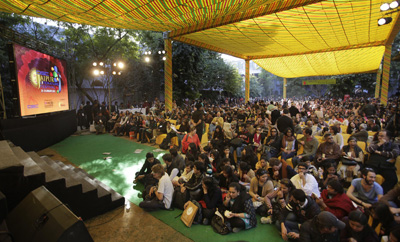Because of criticism from Hindu fundamentalists, the showing of a documentary by filmmaker Sanjay Kak at the Symbiosis College of Arts and Commerce in Pune has been indefinitely postponed. The conservative student organization Akhil Bharatiya Vidyarthi Parisha protested Kak’s film, “Jashn-e-Azadi” (How we celebrate freedom), which is critical of the Indian army’s role in Kashmir. In fact, the whole conference, scheduled to start Friday, has been postponed, according to the investigative magazine Tehelka and the BBC.
This kerfuffle comes shortly after the organizers of the Jaipur Literary Festival cancelled a video link with Indian-born author Salman Rushdie on January 24, the last day of the high-profile event. Ignoring critics who accused the organizers of censorship, Sanjoy Roy, the festival’s producer, said the video interaction had to be cancelled to prevent violence by Muslims activists who, the local police said, had entered the crowded venue of the festival. “We have been pushed to the wall,” said an emotionally charged Roy. The controversy has turned on whether the threats to Rushdie were real; the writer initially decided not to attend the festival because he believed it would be unsafe, but came to believe that Rajasthan state police had fabricated the threats to keep him away. Home Minister P. Chidambaram denied Rushdie’s claim at a press conference.
Regardless of what really happened in Jaipur, there are endless examples of very real and very physical threats to writers, documentary makers, cartoonists, and journalists in India. The question is what the appropriate response should be. Instead of silencing those who might be attacked, it’s up to local and national authorities to act aggressively to protect free expression legally and to prosecute attackers.
In recent weeks, CPJ has reported on a cartoonist coming under legal pressure, not for criticizing politicians (who are apparently considered fair game) but for mocking the state. We also reported on a January 28 attack by dozens of supporters of the Shiv Sena, a rightwing Hindu nationalist party, on the Times of India building in Mumbai, protesting an article that ran in the Maharashtra Times, a Marathi-language daily that is part of the Times of India group. The group was angered by the newspaper’s coverage of their internal politics. Police have arrested 28 people so far, according to a Times report.
In December, we noted in a blog headlined “India struggles to cope with growing Internet penetration” that grassroots activists were using local courts to confront what they considered controversial Web content and its near-universal accessibility, with little oversight, to India’s vast population. The local courts are often sympathetic, handing down decisions to have the online material suppressed that are largely unenforceable for the companies hosting the material. And, while resorting to the courts is much better than trashing a newspaper office or threatening death, an overly litigious atmosphere can prove to be almost as daunting to the media in the long run.
None of this is new in India, as CPJ has recorded over the years. And while the state is sometimes involved in the pressure on media (see the CPJ September 2011 alert on a freelancer charged with antistate activities and numerous alerts on the suppression and abuse of journalists covering the battle over Kashmir), anti-media pressure is just as likely to come from conflicting groups within the country: Maoists, and the vigilante groups confronting them; religious groups, some of them wearing the cloak of nationalism; patriotic grassroots organizations, or disgruntled power elites angered by coverage of corrupt practices, just to mention a few.
CPJ data showthat 30 journalists and media workers have been killed in India for their work since 1992. Slightly more than 50 percent of them had covered business or corruption; only 4 percent were covering violent conflicts. CPJ counts 17 others dead possibly because of their work, but with enough doubt about the motive for us not to include them with the larger number. Globally, India ranks as the eighth most deadly country for journalists. And it joins five other South Asian nations–Sri Lanka, Afghanistan, Nepal, Pakistan, and Bangladesh–among the 20 worst countries on our global Impunity Index, which spotlights countries where journalists are slain and their killers go free. India ranks 13th on the Impunity Index.
The problems of sectarian strife are not unique to India, or even South Asia. But it is the government’s responsibility to move beyond the rationale of not wanting to inflame the cultural differences among its 1.2 billion people to address the conditions under which its journalists work. India cannot easily solve all of its society’s many pressing problems, but it can begin to attack the sad record of impunity that has allowed the deaths of so many journalists to go unpunished.
